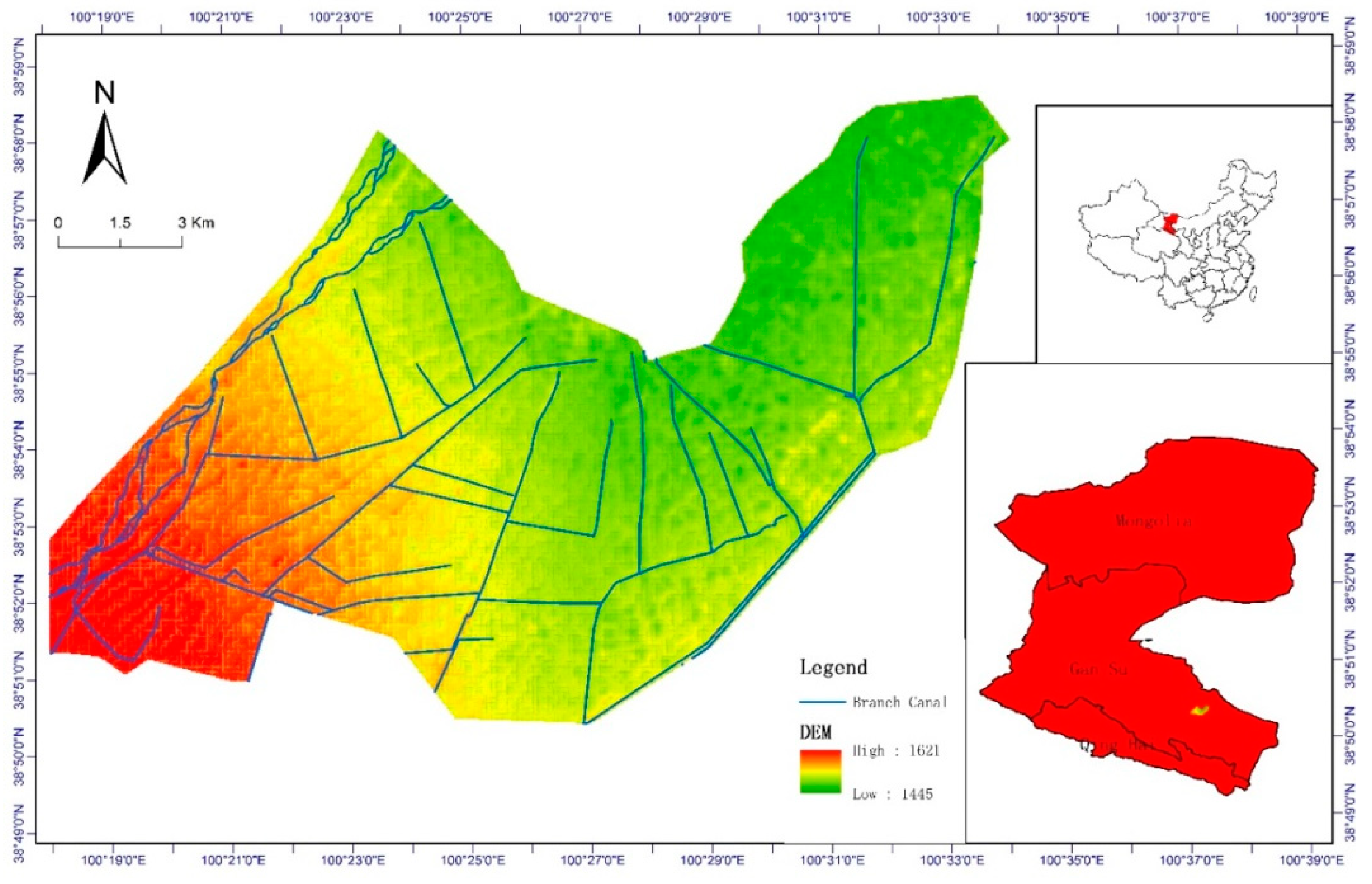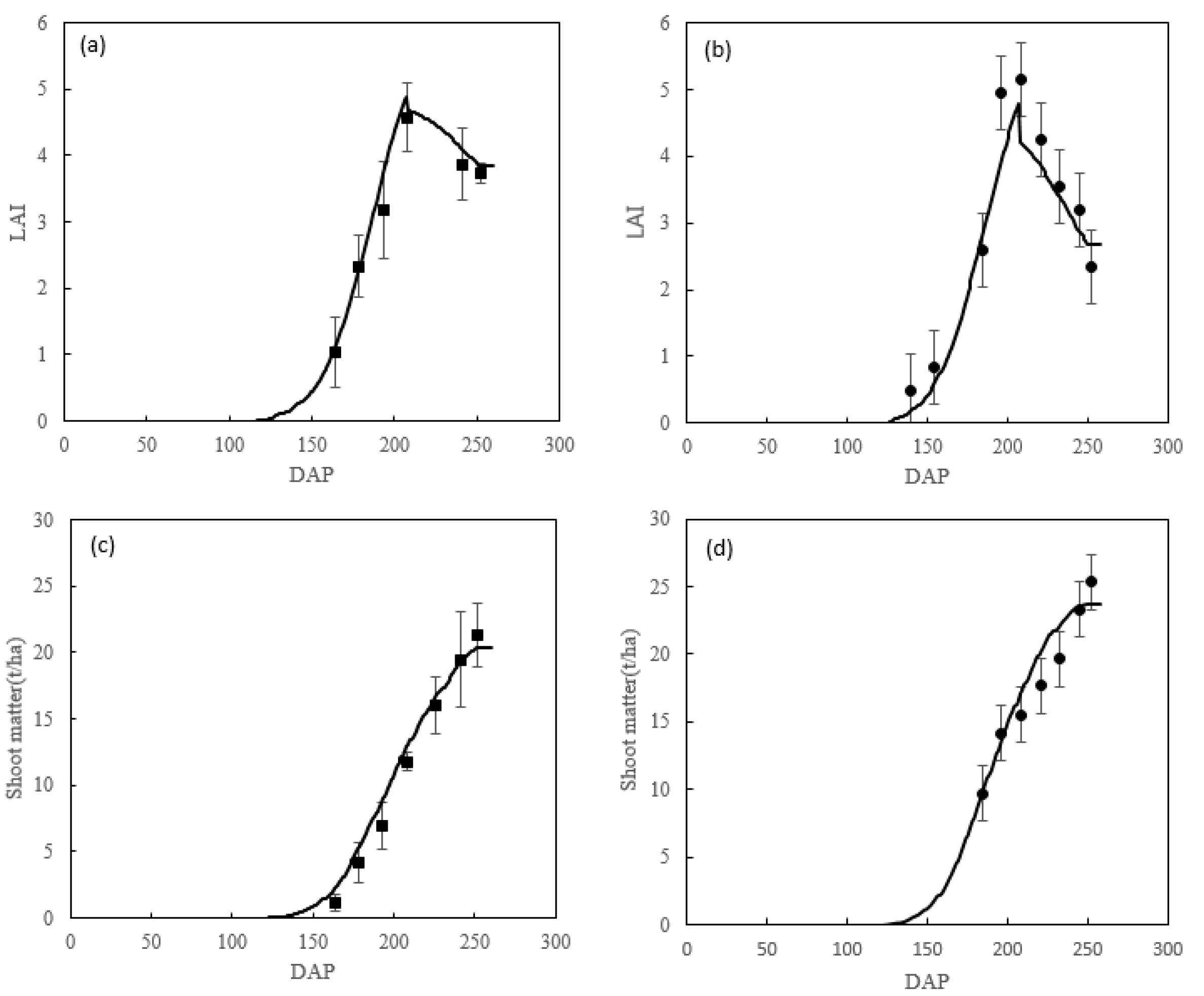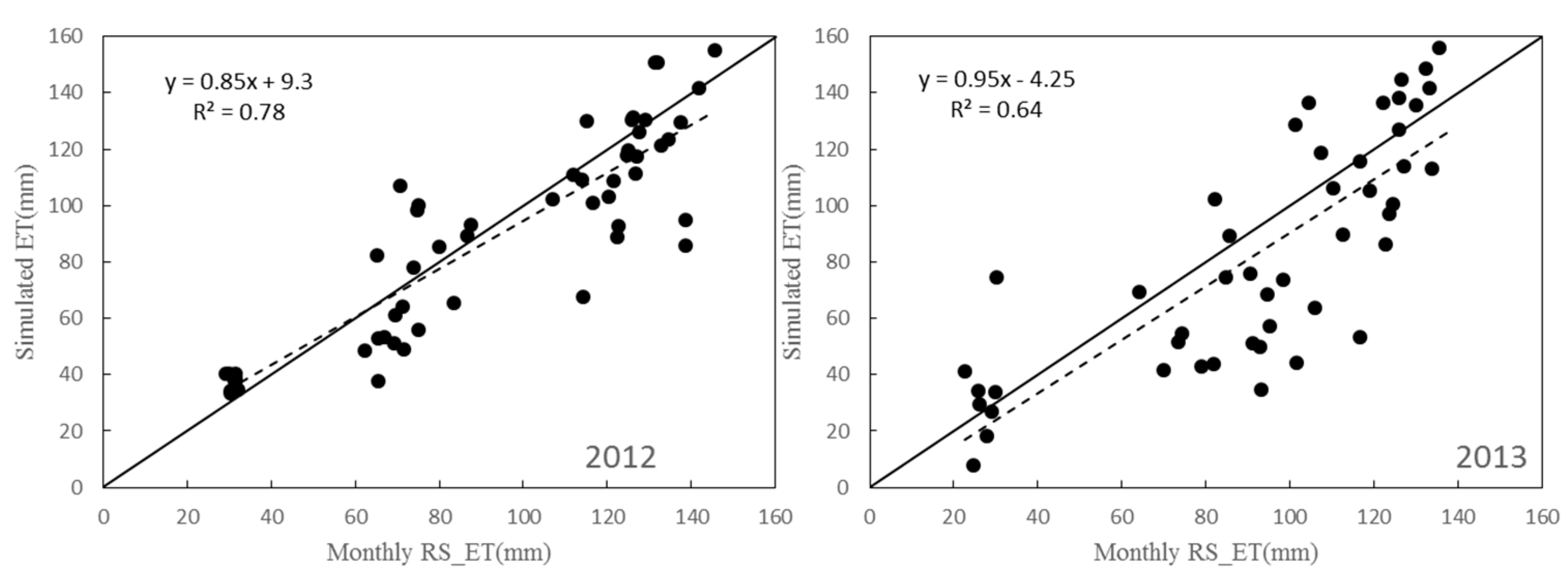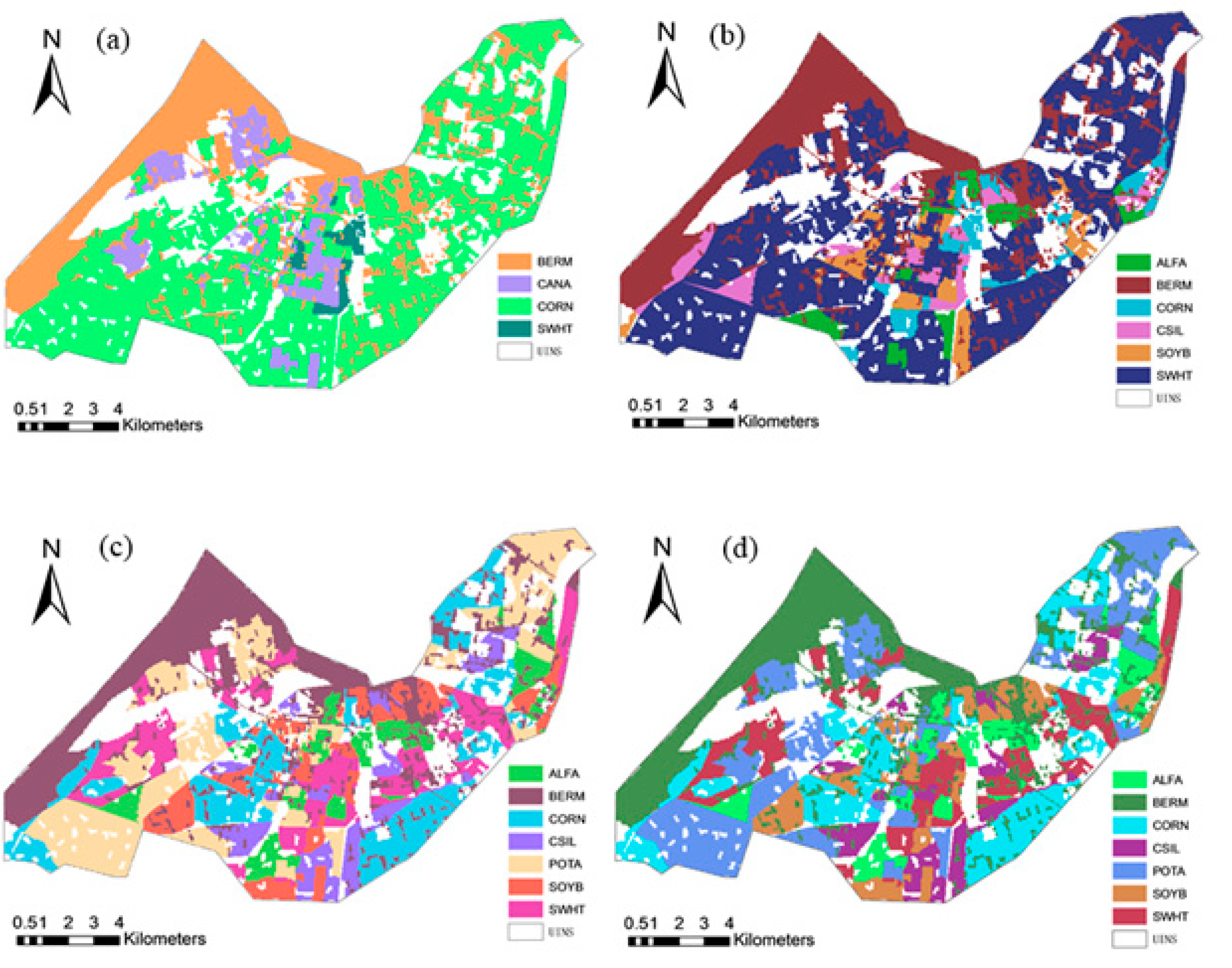1. Introduction
Water has been identified as one of the most limiting factors for ecosystem functioning in the arid district due to limited and unevenly distributed freshwater resources and high water demands to support its large cropland area, huge population, and rapid industrialization. Water resources allocation is an important means to realize effective and reasonable distribution of water resources between different regions and users and to promote the efficient and rational use of water resources [
1]. The allocation of water resources in an arid irrigation district provides an important scientific basis for the efficient utilization of water resources, the ecological management of the basin, and the sustainable development of the society and economy. This is not only related to the irrigation engineering condition, the water management level, and the application of irrigation technology, but also closely related to a reasonable crop planting structure (spatial-temporal distribution of crop water requirements). Such information is critical for policy makers to design strategies for regional sustainability.
The optimization and adjustment of crop planting structure has long been an important research content of agricultural geography and sustainable development of agriculture, and it has attracted great attention of scholars [
2]. Regional crop water requirements are one of the main factors affecting the total irrigation amount. A reasonable arrangement of regional crop planting proportions can reduce crop water requirements in the region, and it can also reduce the total amount of irrigation taking advantage of the irrigation efficiency indicators, which comprehensively reflect the management and engineering conditions of irrigation districts. As to the irrigation efficiency index, Israelsen defined irrigation efficiency as the ratio of irrigation water in the field to the actual imported irrigation water. Irrigation water use efficiency is the ratio of the amount of water available to crops in the field to the total amount of water from the source, and it is an important index to evaluate the efficiency of agricultural water use in irrigation areas. Some scholars have studied the performance indexes of different irrigation systems in different areas [
3,
4,
5,
6]. With the development of research on water-saving irrigation, previous studies have shown that water use efficiency can reflect the cyclicity and spatial variability of water [
7]. The adjustment of planting structure changes the surface biochemical process, farmland hydrological cycle process, and ecosystem productivity by adjusting crop species, varieties and area. For agricultural water use, it directly affects the total water demand of each crop, causing the total water demand of all crops to change after structural adjustment. Research has shown that when arranging a water-saving agricultural planting structure, the continuity of the agricultural ecological system should be protected [
8]. In Korla, the southern Xinjiang Autonomous Region of western China, a typical arid area, the suitable ratio of grain, economic crops, and orchard, while considering the reasonable allocation of water resources, is 26:56:18 [
9]. The water requirement of a plant is a key factor for irrigation efficiency, and thus, irrigation efficiency should be changed as agricultural planting structure being changed. However, related studies have focused on (1) the effect of planting structure changes on water requirement and (2) planting structure optimization with limited water resources [
10,
11].
The distributed hydrological model can be used to evaluate the water use efficiency of irrigated areas in multiple scales, which can provide technical support for the improvement of water-saving in irrigated areas. The Soil and Water Assessment Tool (SWAT) model can predict the impact of different soil types, land use patterns, and management conditions on the hydrological cycle of the basin. According to the comprehensive review of studies on SWAT model by Gassman et al. [
12], only a few literatures have conducted simulation and verification research on ET with SWAT model. Arnold et al. simulated ET using the SWAT model and verified ET while using traditional methods. Immerzeel and Droogers rate the simulated ET of SWAT model based on remote sensing ET. The use of remote sensing monitoring of regional distribution ET directly to the SWAT model simulation of ET rate is a relatively new model research method. Cui used the improved SWAT model to analyze the simulation of irrigation water consumption in the southern multi source irrigation area [
13]. However, in the field of hydrological models, the key to using the SWAT model for ET simulation is to select reasonable soil and crop growth parameters. At present, there are few related studies in this area [
14,
15,
16,
17,
18,
19,
20]. Based on the current water resources situation, most scholars discuss the planting structure adjustment policy and future development trends from the perspective of regional plant structure evolution, hydrological change response, and structural adjustment [
21,
22].
The main objective of this study were (i) calculating the irrigation efficiency, considering water draining, based on a further simplification of the irrigation efficiency calculation formula and the definition of the boundary of the spatial scale; (ii) setting up different planting structures and evaluating the changes in water saving amount, the irrigation water productivity, and the net income water productivity in different scenarios of irrigation district projects.
4. Results and Discussions
4.1. SWAT Model Verification
According to the comparison diagram between the simulated and the measured values of the LAI model, the LAI and the determination coefficients of the measured values that were simulated by the modified SWAT model are 0.94 and 0.98, the root mean square errors are 0.25 and 0.53, and the validity indices of the model are 0.95 and 0.89. According to the comparison diagram between the simulated and the measured values of shoot dry matter, the determination coefficients of the measured value simulated by the modified SWAT model are 0.99 and 0.92, the root mean square errors are 1.16 and 1.60 t/ha, and the validity indices of the model are 0.97 and 0.90. According to the comparison diagram between the simulated and the measured values of the monthly ET model, the monthly ET simulated by the modified SWAT model, and the determination coefficients of the monthly ET obtained by remote sensing inversion are 0.87 and 0.47, the root mean square errors are 7.40 and 36.62 mm/month, and the validity indices of the model are 0.76 and 0.42.
Consequently, the decision coefficients, the root mean square errors and the validity indices of the modified SWAT model for the LAI, shoot dry matter, and the simulation of monthly ET are all in a reasonable range (
Table 3). In other words, the simulation results reflect the evapotranspiration and growth of crops and can be used to simulate the water circulation process and to analyse the irrigation efficiency in irrigation districts [
52,
53,
54,
55,
56,
57].
4.2. Irrigation Efficiency Considering Drainage
The values of the irrigation efficiency in the Yingke irrigation district in 2012 and 2013 are, respectively, 0.51 and 0.48 when calculated by Equation (1). However, the values of the irrigation efficiency are 0.59 and 0.56 considering drainage, which is a 16.9% and 16.3% improvement when compared with the traditional method. The Yingke irrigation district is an arid irrigation district, and the runoff yields of the whole irrigation district are, respectively, 14.70 and 14.19 million m
3, as calculated by the modified SWAT model (
Table 4), which accounts for 14.5% and 14% of the total irrigation amount in irrigation district.
Zhang [
58,
59] has researched the characteristics of water circulation in the Hetao irrigation district while using the distributed hydrological model and identified that the amount of drainage is 12.6% of the sum of the amount of irrigation and the amount of precipitation. This paper is more consistent with these results, and the effective coefficients of irrigation water utilization when considering drainage more accurately reflects the actual situation of water consumption in the irrigation district.
According to the comparison between traditional irrigation efficiency and irrigation efficiency while considering drainage, the irrigation efficiency considering drainage is 15% more than the traditional irrigation efficiency. Thus, it is necessary to consider the water flowing out of the spatial scale. Considering the original loss of water quantity will only result in a lower calculated result.
4.3. Scenario Analysis
According to the
Figure 6, the yields and ET values of different types of crops simulated by the model are consistent with the statistical values and the error is less than 10% [
60]. In terms of yield, POTA (Potato) has the highest yield of 18,678 kg/ha, followed by CORN (Corn for seed), CSIL (Field corn), and ALFA( Alfalfa), with yields of 9233 kg/ha, 9371 kg/ha, and 10,283 kg/ha, respectively. SOYB (Soybean) yield is the smallest, only 2403 kg/ha. In terms of ET, the ET of CSIL is the highest, which reached 506 mm, followed by CORN, ALFA, SOBY, and CANA (Spring canola-Argentine), the ET is 494 mm, 430 mm, 429 mm, and 426 mm, respectively, while the ET of POTA is the lowest, only 365 mm, of which SWHT (Spring wheat) is higher than POTA. In terms of ET, the ET of CSIL is the highest, which reached 506 mm, followed by CORN, ALFA, SOBY, and CANA, the ET is 494 mm, 430 mm, 429 mm and 426 mm, respectively, while the ET of POTA is the lowest, only 365 mm, of which SWHT is higher than POTA In terms of the difference in evapotranspiration, the difference between CORN and POTA is substantial, while the differences among the others are small.
According to the analysis results, CSIL has the largest amount of ET, but its yield is not the largest, while POTA with a small amount of ET reached the maximum yield in the selected crops, for the SWHT, CANA, and SOYB with small yields, the ET are relatively large. Therefore, the variation relationship between yield and ET of different crops should be analyzed according to the species of crops.
4.3.1. Water Saving Analysis
The average values of evapotranspiration in the Yingke district in 2012 and 2013 is 65.343 million m
3, and the range of evapotranspiration in the Yingke district under different planting structures is 55.56~67.60 million m
3, which means that the variation range is −14.98–3.45% as compared with the current evapotranspiration rates in the Yingke district. From the aspect of the water requirement in the irrigation district, 9.786 million m
3 of the water requirements can be reduced at most. The average effective precipitation in 2012 and 2013 is 15.176 million m
3, and the irrigation efficiency while considering drainage is 0.57, so the water diversion range of the canal head in the irrigation district is 70.050–100.820 million m
3. Thus, the water diversion range of the canal head in the irrigation district can be reduced by the adjustment of planting structures and the amount of water saved can be up to 30.77 million m
3, which accounts for 30.52% of the total irrigation water in the current irrigation district. The water diversion range of the canal head in the irrigation district can be reduced by up to 31.345 million m
3. Under the condition of constant pumping irrigation water, the decrease in amplitude is up to 45.56%. The proportion of corresponding planting structure is shown in
Table 5 and
Figure 7.
Therefore, it is feasible to lower the pumping irrigation and raise the water level. From the perspective of the proportion of water-saving potential being generated by various measures, the amount of water-saving generated by reducing irrigation quota through strengthening water management and providing irrigation water utilization coefficient through implementing water-saving engineering measures still accounts for the majority, but the amount of water saving generated by optimizing planting structure is also considerable.
According to the relationship between the amount of water saved and the planting areas (
Table 6), the amount of water saved is inversely proportional to the planting areas of crops with high water requirements (such as CORN and CSIL), which means that the larger the planting areas are, the smaller the amount of water saving is. To the contrary, the amount of water saved is proportional to the planting areas of crops with low water requirements, such as SWHT and POTA, which means that the larger the planting areas are, the larger the amount of water saving is. The results are similar to those of previous studies [
61].
4.3.2. Irrigation Water Productivity Analysis
The average value of irrigation water productivity in the Yingke district in 2012 and 2013 is 6.63 yuan/m
3, and the range of irrigation water productivity in the Yingke district under different planting structures is 2.33–6.72 yuan/m, which means that the variation range is −64.86–1.36% as compared with the current irrigation water productivity in the Yingke district. The crop with the largest planting area is corn for seed and its unit price is also higher (Shown
Table 2). Thus, the irrigation water productivity of the corn for seed in the Yingke district is relatively high. From the point of view of irrigation water productivity, 1.36% of the irrigation water productivity can be increased at most under 800 combinations of scenarios. The total irrigation amount in this circumstance is 87.61 million m³ and the total water requirement is 55.02 million m
3, both of which are less than the amount of water that is consumed in the irrigation district. The proportion of the corresponding planting structure is shown in
Table 5 and
Figure 7. Therefore, the irrigation water productivity in the current Yingke irrigation district is high, and there is an optimal scenario that is larger than the current, but the increase should be small.
According to the relationship between irrigation water productivity [
62] and planting areas (
Table 6), the irrigation water productivity is proportional to the planting areas of crops with high yields and unit prices, such as corn for seed and potatoes, which means that the larger the planting areas are, the bigger the irrigation water productivity is. To the contrary, the irrigation water productivity is inversely proportional to the planting areas of crops with low yields and unit prices, such as wheat and soybean.
4.3.3. Net Water Productivity Analysis
The average value of net water productivity in the Yingke district in 2012 and 2013 was 2.73 yuan/m
3, and the range of net water productivity in the Yingke district under different planting structures was 1.94–3.17 yuan/m
3, which means the variation range is −28.93–16.11% when compared with the current net water productivity in the Yingke district. From the point of view of the net income of crops, the net income of potatoes and corn for seed are the largest and they are 923.64 and 1374.8 yuan/hm
2. Thus, increasing the planting area ratio of crops with a high net income can greatly improve the net water productivity in the whole irrigation district. The optimal planting structure is shown in
Table 5 and
Figure 7 under the existing planting scenario combinations
According to the correlation coefficients of the net water productivity [
63] and the planting areas of crops, the increase in net water productivity is inversely proportional to the planting areas of crops with low net income, such as wheats. The correlation coefficient is −0.52; the larger the planting areas of wheats are, the smaller the increase in net water productivity is. To the contrary, the increase in net water productivity is proportional to the planting areas of crops with high net income, such as potatoes. The correlation coefficient is 0.94; the larger the planting areas of potatoes, the larger the increase in net water productivity.
This shows that reducing the area of crops with low water efficiency and low economic value and increasing the area of crops with high water efficiency and high economic value can increase farmers’ income and reduce agricultural investment [
64].
5. Conclusions
Based on the improved SWAT model, the observation data of yingke irrigated area from 2012 to 2013 were used to calibrate and verify the SWAT model, and a higher accuracy was obtained. It shows that the simulation results can better reflect the evapotranspiration and growth of crops, so it can be used to simulate the water cycle process and analyze the irrigation efficiency of irrigation areas.
The scenario analysis method of the spatial distribution of crop planting structure was established to analyze the changes of irrigation efficiency under different planting structure scenarios. When considering the irrigation efficiency of drainage, the actual water consumption in the irrigated area was more accurately reflected as compared with the conventional irrigation efficiency, and the irrigation efficiency was improved by 15–20%.
The adjustment of crop planting structure can change crop water requirement and economic output. Planting crops with low water consumption and high economic benefits can effectively reduce regional evapotranspiration by 14.9%, regional irrigation by 30%, and net income by 16%.
This paper aims at changing the water and material circulation process of irrigated areas through rational allocation of crop planting structure, increasing water-saving amount in irrigated areas, and improving farmland water production efficiency, which is helpful for guiding rational allocation of water resources in irrigated areas. More comprehensive crop species will be selected for analysis in subsequent studies.












